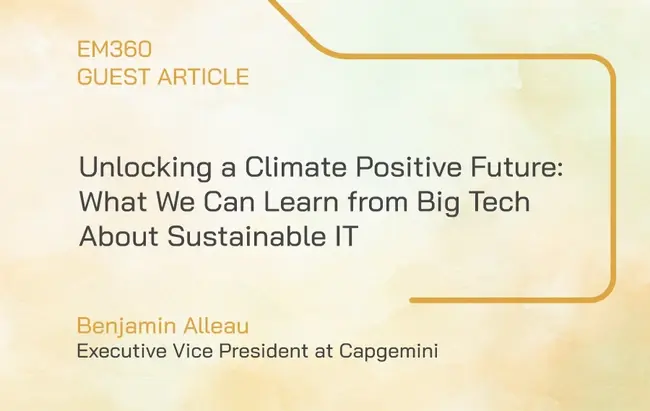Benjamin Alleau, Group Sustainability Offering Lead, Capgemini and Managing Director Business Technology, Capgemini Invent
In recent years, fires, floods, and other extreme weather events have become increasingly frequent, and the issue of climate change more acute. With the IPCC’s landmark report suggesting global temperatures are likely to rise by more than 1.5C in the next two decades, the picture today is clear – action needs to be taken, quickly and decisively.
As organizations seek to do their part in reducing global greenhouse gas emissions, they are increasingly adopting technology solutions like machine learning and AI, as well as IT processes to streamline operations and reduce emissions.
But while this technology has the potential to boost sustainability, it leaves its own mark on the environment. In fact, digital technologies today represent between 3% and 4% of global CO2 emissions – more than the entire aviation industry. If IT was a country, it would rank third in terms of energy consumption, just after China and the U.S.
This challenge needs to be addressed head on. Fortunately, IT leaders can scale-up their ambitions by observing and learning from ‘big tech’ firms that have taken proactive steps to decarbonize their operations.
Most organizations still do not view sustainable IT as a priority. Only 22% of businesses have plans to reduce their carbon footprint by more than a quarter using sustainable IT. Given the general lack of awareness of enterprise IT emissions, this is perhaps unsurprising. Only 57% of global leaders are unsure about their own organization’s IT carbon footprint.
In many ways, the technology sector represents a bastion of hope for global efforts to combat climate change. Microsoft, for example, is planning to become carbon negative by 2030, and 70% of its data centers will run on renewable energy by 2023. Likewise, HP has set a target to ensure its global operations are powered with 100% renewable electricity by 2035, and Samsung has a goal to recycle 7.5 billion pounds of electronics waste by 2030.
These big tech players today are making a name for themselves by taking proactive measures to decarbonize their IT operations, services, and products. So, what initiatives can be adopted from the technology frontrunners and where can enterprise IT leaders begin?

Rationalizing energy consumption
Understanding where energy is being expended in your organization will naturally have a major impact on reducing emissions, but the application landscape is often overlooked. Only 19% of organizations are measuring the energy impact of their production application environments (development and testing), and only 21% measure the sustainability impact of the production environment (live applications).
One firm which has developed a solution to these challenges is Intel, with its Software Development Assistant. This tool enables programmers and engineers to take energy measurements from a system as it executes specific workloads, helping rationalize applications and identify and decouple those which are energy-intensive.
Sustainable architectures to rationalize applications are one of the most carbon-efficient use cases today according to Capgemini, with the potential to deliver 11% operational cost savings.
Establishing climate-positive policies for procurement
It is often said that you are who you associate with, and this is a mantra that many technology organizations operate by. While 53% of global organizations say environmental impact isn’t a criterion considered when selecting an IT vendor, tech giant Cisco has taken a different approach.
Cisco directly influences suppliers to ensure that they are using carbon-focused sourcing strategies, model designs, product fulfilment, manufacturing energy use and transport mode selection. The company is also working with the Carbon Disclose Project so that it is transparent about progress against its overall goal to cut one million metric tons of greenhouse gas emissions across its supply chain.
To become truly sustainable, strategies must be deployed across not only organizations but also to partners and vendors. This way, organizations across all sectors can ensure vendors are transparent and accountable on their IT norms as part of a sustainable IT procurement policy.
Get serious about carbon costs
Setting a carbon cost against IT operations can help different functions within the organization fully understand the impact of their IT footprint. Faced with the challenge of including carbon costs alongside other expenditures in their annual budgets, business leaders and executives are often mobilized to action.
Currently, however, only 27% of global businesses have set this cost. Microsoft is one such pioneer, having introduced internal carbon fees back in 2012. These are levied on internal business units for the carbon emissions associated with the company’s global operations for datacenters, offices, labs, manufacturing, and business air travel. By placing carbon costs against energy-intensive operations, IT leaders can both drive and incentivize sustainable enterprise IT.
Accelerating a sustainable future
As we look to a post-pandemic recovery, sustainability must be at the core of the world’s efforts to build back better. IT and business decision makers must take up the challenge of leading the way, prioritizing awareness and education. To give sustainable IT the attention it deserves, organizations need to understand the carbon cost of the digital world and accelerate their move to sustainable systems.
Commitment from critical stakeholders is essential to drive and embed sustainable IT approaches. Executives need to be asking themselves whether they understand where emissions are coming from across their business’s IT functions and how these are being measured. Sustainable IT is not only necessary for a more climate-positive future; but it will unleash the potential of smart technologies to drive environmental innovations and improvements in cleaner performance.







Comments ( 0 )